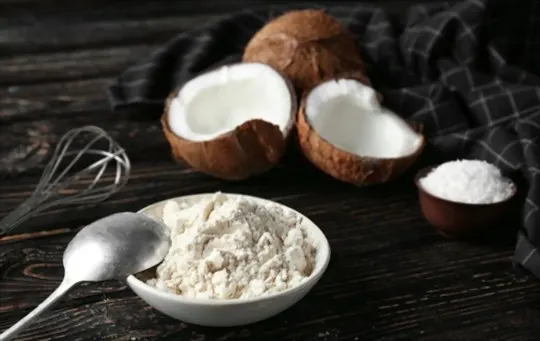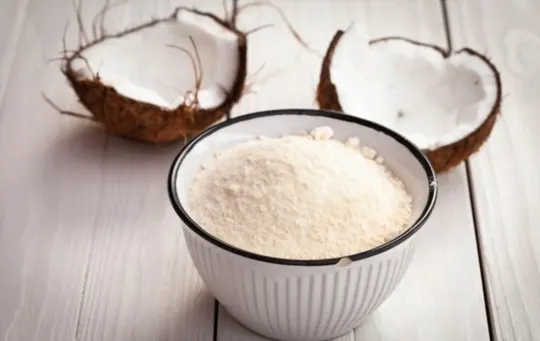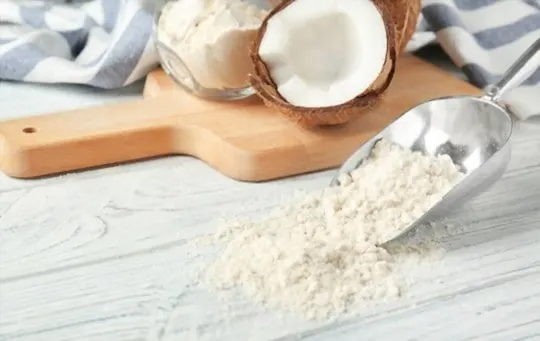We’re all aware of the widely celebrated coconut milk and its wonders for our health.
But what is not known to many is that coconut has much more uses than its milk.
The by-product you obtain at the end of the process can make a healthier upgrade to the mundane ways we use flour.
What does coconut flour taste like, and what is its place among the many flours available?
We’ll break down all the interesting facts about this not-so-common flour, and it’ll help if you scroll on.
What is Coconut Flour?

Coconut flour is made by grinding the leftover coconut meat into a fine powder.
It is off-white in color and thick, so you’ll need more water to get the same consistency as all-purpose flour.
You can use it in almost any flour recipe, but most people love to use it for baking.
The faint aroma of coconut makes any baked treats even more addicting to eat.
Coconut flour has a lot of uses, and making it is so simple as long as you have whole coconuts at hand.
Making coconut flour includes blending coconut meat and straining the liquid.
Then it is baked in low heat until completely dry.
Once this is achieved, you can ground the coconut meat into a powder-like consistency.
With such an easy preparation, you can now ground your flour in the comfort of your home.
What Does Coconut Flour Taste Like?

Coconut flour tastes sweet and has a mild flavor to the fruit.
Though considered flour, it does not have any similarity with regular flour in taste, smell, or nutrition.
The distinct coconut flavor is prominent in all 100% coconut flour, and they have a coarse texture, which adds an exciting accent to the flour.
And if you’re not a fan of coconuts, you can get rid of their taste by using more robust flavors that will overwhelm the natural coconut flavor.
If you compare coconut flour to other items, such as wheat and rice flour, you’ll find that the coconut variant has many more nutritional benefits.
It is gluten-free, low in carbs, and high in fiber, fat, and protein.
Don’t let the fat scare you because they’re healthy ones that will reward you in the long run.
So, why should you choose coconut flour? Firstly, it is an excellent option for a gluten-free diet, and you won’t be a target of gluten-induced diseases.
Another reason is that coconut flour is also paleo diet friendly.
Also, your blood sugar levels will not witness any abnormality as the flour has a low glycemic index (GI).
A high GI will cause an unusual spike in your blood sugar which is especially bad for people with diabetes.
Although you can use coconut flour as a substitute for recipes including flour, you need to step back and think if it’ll work.
For instance, if the recipe is for something light, you cannot use coconut flour because it is somewhat thick in texture.
One healthy alternative to coconut flour is almond flour.
It is also gluten-free and is beneficial to your health in many ways.
How to Use Coconut Flour?

Now that you know how beneficial the flour is, you shouldn’t wait to try some fantastic ways you can make use of coconut four, and here are our favorites:
- Make a crêpe: Doesn’t the idea of wrapping all your delicious food in crêpes sound like the perfect lunch item? If yes, why not make it better by using coconut flour as the base ingredient?
- Use as a thickener: If you’ve run out of thickeners for your soups and sauces, try coconut flour, and you’ll be impressed by the result. It works as an alternative to corn flour.
- Bake some cookies: Making cookies with coconut flour is a cheat when it comes to adding a depth of flavor to regular food. They also add an exciting texture.
There isn’t any harm in consuming coconut flour; however, you should take care to use it in moderation.
The high fiber content may trigger gastrointestinal issues and make you feel boated.
But fear not; this only happens with overeating.
Also, coconut flour can sometimes be dry to eat, so you can balance this by adding more eggs to achieve the perfect consistency.
Final Thought
Coconut flour has many prospects and may well substitute for any other flour.
Its sweet taste is what makes it so special and easy to flavor.
Other than its distinct taste, coconut four has so many uses in cooking that you’ll never run out of recipes to use it in.
Coconut flour, being gluten-free, is among the best options for those who use flour daily.
So now you know how versatile and flavorful the flour is, you shouldn’t leave your pantry without some coconut flour to use now and then.

What Does Coconut Flour Taste Like? Does It Taste Good?
Ingredients
- Coconut flour
- Ingredients from your favorite recipes
Instructions
- Depending on the ingredients used, the cooking method, and the type of dish, the taste of the food can vary greatly.
- Make sure to select a recipe that will elevate the food’s original flavor, and enjoy experimenting with different recipes!

Andrew Gray is a seasoned food writer and blogger with a wealth of experience in the restaurant and catering industries. With a passion for all things delicious, Andrew has honed his culinary expertise through his work as a personal chef and caterer.
His love for food led him to venture into food writing, where he has contributed to various online publications, sharing his knowledge and insights on the culinary world. As the proud owner of AmericasRestaurant.com, Andrew covers a wide range of topics, including recipes, restaurant reviews, product recommendations, and culinary tips.
Through his website, he aims to inspire and educate fellow food enthusiasts, offering a comprehensive resource for all things food-related.

Leave a comment